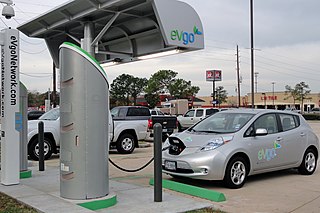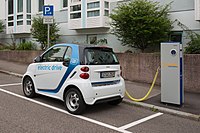Related Research Articles

An electric car or electric vehicle (EV) is a passenger automobile that is propelled by an electric traction motor, using electrical energy as the primary source of propulsion. The term normally refers to a plug-in electric vehicle, typically a battery electric vehicle (BEV), which only uses energy stored in on-board battery packs, but broadly may also include plug-in hybrid electric vehicle (PHEV), range-extended electric vehicle (REEV) and fuel cell electric vehicle (FCEV), which can convert electric power from other fuels via a generator or a fuel cell.

As of March 2022, there were about 62,000 electric vehicles in New York, accounting for 0.6% of all vehicles in the state.
Rivian Automotive, Inc., is an American electric vehicle manufacturer and automotive technology and outdoor recreation company founded in 2009. Rivian produces an electric sport utility vehicle (SUV), a pickup truck on a "skateboard" platform that can support future vehicles or be adopted by other companies, and an electric delivery van, the Rivian EDV. Rivian started deliveries of its R1T pickup truck in late 2021. The company planned to build an exclusive charging network in the United States and Canada by the end of 2023.

As of 18 April 2023, there were 185,511 electric vehicles registered in Texas.
As of June 2021, there were about 29,000 electric vehicles registered in Arizona, equivalent to one for every 250 residents, the seventh-highest in the United States.
As of December 2021, there were about 17,000 electric vehicles in Nevada, accounting for 0.7% of vehicles in the state. Electric vehicles account for about 4.6% of all vehicle sales in the state.
As of September 2023, there were 93,931 electric vehicles on the road in the U.S. state of Colorado. As of September 2023, 11.05% of new vehicle registrations in the state were electric. The most popular EVs in the state in 2023 were the Tesla Model Y and Model 3, with 16,537 and 14,013 registrations, respectively.

As of 2021, there were about 24,000 electric vehicles in the U.S. state of Georgia, accounting for 1.0% of all vehicles in the state.
As of October 2021, there were about 33,000 electric vehicles in Illinois.
As of July 2023, there were about 36,000 electric vehicles registered in Connecticut. About 25% of vehicles registered in the state between July and December 2021 were electric.
As of March 2021, there were about 4,000 electric vehicles in Delaware. As of May 2023, there were just 142 charging locations located in Delaware, putting Delaware in the bottom 10 states for charging stations in the US. According to official sources only 11 new charging stations have been added in the past two years. Information for Delaware's laws and incentives for electric vehicles can be found at the United States Department of Energy's Alternative Fuel Data Center.
As of May 2022, there were about 24,500 electric vehicles in Ohio.
As of March 2022, there were about 76,000 fully electric vehicles and 57,000 plug-in hybrid vehicles in Quebec. As of 2021, about 6.8% of new vehicle registrations in Quebec were electric.
As of April 2021, there were about 7,000 electric vehicles registered in Indiana.
As of July 2023, there were 15,400 plug-in electric vehicles registered in Alabama.
As of April 2022, there were about 3,700 electric vehicles registered in Kentucky.
As of June 2021, there were 3,410 electric vehicles registered in Oklahoma.
As of June 2022, there were about 3,000 electric vehicles in Arkansas.
As of 2022, there were 6,740 electric vehicles in Missouri, equivalent to 0.12% of all vehicles in the state.
As of May 2022, there were 3,130 electric vehicles registered in Kansas, equivalent to 0.12% of all vehicles in the state.
References
- ↑ Walton, Robert (May 2, 2022). "Can the grid handle millions of EVs? In Tennessee, distribution systems will be 'canary in the coal mine'". Utility Dive. Retrieved May 2, 2022.
- ↑ "Electricity Laws and Incentives in Tennessee". afdc.energy.gov. Retrieved September 8, 2022.
- ↑ "Fast Charge TN Network". tn.gov. Retrieved May 15, 2022.
- ↑ Schleicher, Rebecca (March 4, 2022). "Mapping TN electric vehicle corridors for an industry set to boom". WTVF. Retrieved September 8, 2022.
- ↑ Villena, Cole (July 9, 2021). "Electric vehicle production is ramping up in Tennessee. What's it like owning one?". The Tennessean. Retrieved September 8, 2022.
- ↑ "Electric Vehicle Manufacturing". Tennessee Department of Economic and Community Development. Retrieved May 15, 2022.
- ↑ Smith, Nickelle (March 29, 2022). "Electric vehicles in Tennessee triple in 5 years as stakeholders prepare for more". WKRN. Retrieved April 23, 2022.
- ↑ Flessner, Dave (April 28, 2022). "Power demand to grow in Tennessee Valley as economy electrifies, TVA CEO says". Chattanooga Times Free Press. Retrieved May 2, 2022.
- ↑ Doll, Scooter (April 29, 2022). "Volkswagen reportedly considering a second US production site plus new battery cell plant". Electrek. Retrieved May 2, 2022.
- ↑ Wood, Tom (May 6, 2022). "No turning back as automakers go electric". The Nashville Ledger. Retrieved May 7, 2022.

